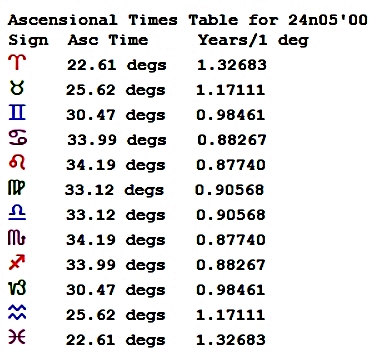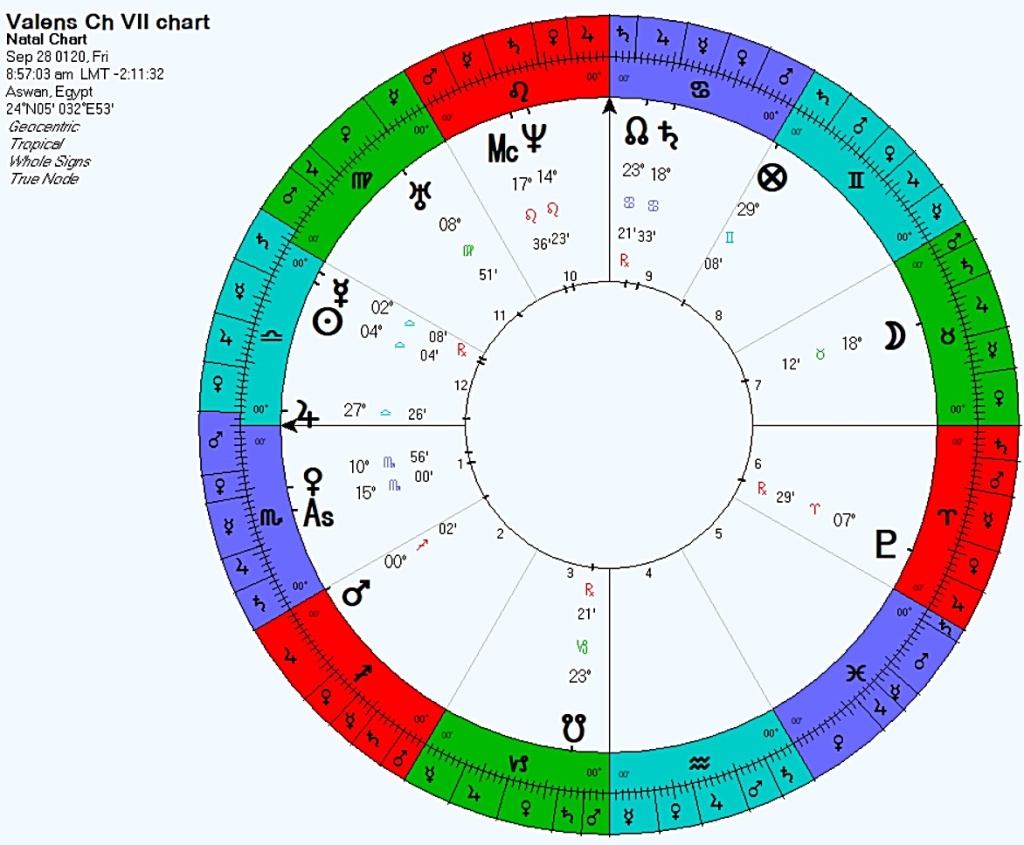In the book Light on Life (1996), the authors, Hart de Fouw and Robert Svoboda, note that Hindu astrologers believe that each planet ripens or reaches “maturation” at a certain age, specifically:
the sun at year 22 (I believe these numbers are ordinal, so 22 refers to the 22nd year.)
the moon at year 24
Mars at year 28
Mercury at year 32
Jupiter at year 16
Venus at year 25
Saturn at year 36
Rahu & Ketu at year 48 (Some sources give the 42nd year, ‘the midlife crisis’, to Rahu and the 48th year to Ketu).
De Fouw and Svoboda also note that “those people who have, for example, Saturn strongly configured with the ascendant in their horoscopes will find that their lives ‘mature’ in some way at 36, the [maturation] age of Saturn. Often this ‘maturation’ occurs in one of the matters that Saturn represents in the horoscope.” (p.69)
Not surprisingly, a similar concept can be found in the Hellenistic literature, specifically in Chapter VII of Vettius Valens’ Anthology. Valens used the so-called “minor” or “small” years of the planets, a concept probably derived from Persian astrology. The “minor” years of a planet are based on recurring cycles in the synodic periods of a planet in its orbit around the Sun. Every so many years each planet conjoins the Sun at approximately the same degree of the zodiac, and the planet is thus considered to reach its maturation stage during that specific whole number of years (rounded to the nearest integer).
In this system of “minor” years of planets, the Sun is given 19 years to mature and to begin a new maturation cycle, based on its Metonic cycle because an eclipse occurs every 19 years (or 254 lunar months of 27.32 days) at the same degree of the zodiac. The planets are assigned maturation periods based on their synodic cycles with the Sun. A synodic cycle is the amount of time which elapses between two successive identical configurations (in this case, Sun-Planet conjunctions) as seen from Earth.
The Moon is believed to mature in 25 years because 25 Egyptian years (of 365 days each) is exactly equivalent to 309 lunation cycles of 29.53 days each.
It turns out that 63 Sun/Mercury synodic cycles is exactly equal to 20 Egyptian years, so Mercury is considered to mature every 20 years. It also happens the five Sun/Venus synodic cycles equals almost exactly 8 Egyptian years, so Venus matures every 8 years and then starts a new maturation cycle.
Seven Sun/Mars synodic cycles equals just under 15 Egyptian years, so Mars matures every 15 years (the actual figure is 14.9577 years).
Eleven Sun/Jupiter synodic cycles equals 12.02 Egyptian years, so Jupiter is assigned a maturation age of 12 years.
Finally, 29 Sun/Saturn synodic cycles equals 30.04 Egyptian years, which are rounded to 30 years as Saturn’s maturation cycle.
In summary, Valens uses the following maturation ages, aka ‘minor years’, of the planets in his predictive work:
Sun – 19 years (the Sun reaches ‘maturity’ in the 19th year of this cycle)
Moon – 25 years (the Moon reaches ‘maturity’ in the 25th year of this cycle)
Mercury – 20 years (Mercury reaches ‘maturity’ in the 20th year of this cycle)
Venus – 8 years (Venus reaches ‘maturity’ in the 8th year of this cycle)
Mars – 15 years (Mars reaches ‘maturity’ in the 15th year of this cycle)
Jupiter – 12 years (Jupiter reaches ‘maturity’ in the 12th year of this cycle)
Saturn – 30 years (Saturn reaches ‘maturity’ in the 30th year of this cycle — the Saturn return)
Valens believed that events related to each planet would occur in the life of the native when he or she reached the year corresponding the the maturation age of the planet. For example, Sun-like events should occur in the 19th year of life (18 y.o. -19 y.o.), lunar events in the 25th year of life (24 y.o. – 25 y.o.), Mercury-related events in the 20th year of life (19 y.o. – 20 y.o.), and so on.
He also believed that such events would occur at integer multiples of these maturation years, as well as at half, one-third, and two-thirds of these periods — perhaps reflecting his awareness of the importance of midpoints and of the division of quadrants of the horoscope into equal thirds. For example, the Ascendant is the midpoint between the Lot of Fortune and the Lot of Spirit (Daimon), and Porphyry houses are generated by dividing each quadrant into equal thirds.
Furthermore, Valens would add together the maturation years of two planets in configuration and also combine maturation years of planets with the ascensional times of the signs they occupied as well as the rulers of their signs. A potential problem with this approach is that by combining so many factors you can almost always come up with some combination of chart factors that “explains” what is happening in the life of the native.
Let’s look at an example from Valens, Chapter VII. This is my reconstruction of a chart described by Valens (not knowing the degree of the Asc, I cast the chart with 15 Scorpio rising). According to Ptolemy’s table of ‘Klimes’, the native was born roughly around latitude 24N:
—–
From the Mark Riley translation:
“An example: sun, Jupiter, Mercury in Libra, moon in Taurus, Saturn in Cancer, Mars in Sagittarius; Venus, Ascendant in Scorpio, klima 2.
During his 40th year he was condemned to exile.
The 40th year was indicated by the superior aspect of Saturn to Libra: 32 degrees for Cancer plus 8 for Libra <=Venus> total 40.
Also the opposition of the moon to Venus : 25 for Taurus <=moon> plus 15 for Scorpio <=Mars> total 40. Consequently the results were activated through female persons and for the purpose of profit.
And again the “contact” of the moon with Mars : 25 for the moon plus 15 for Mars total 40.
(As the King says: “Let the moon be in any sign or at an angle, and let the star of Mars be just preceding or just following the moon in the contiguous sign; then the moon has ‘contact’ with it. And so, even if the star is not in the same sign as the moon, but is found in the adjoining sign, or in the sign in square or in opposition, then consider the contact to be solid. Sum up their periods or the rising times of the signs to forecast the chronocratorship.”)”
End of Mark Riley translation
—–
Valens begins with Saturn in Cancer in a superior square to the 12th whole sign Libra, as an indication of exile. Rather than use the age of maturation of the planet Saturn (30 years), he uses the ascensional time of Cancer (32 degrees = years in his tables), and he then combines the ascensional time of the sign Cancer with the minor years of the planet Venus (8 years), the ruler of Libra, to come up with a total of 40, indicating the 40th year.
His second argument is Moon (25 years) in Taurus (25 years in his system) opposed to Venus (8 years) in Scorpio ruled by Mars (15 years). Here he combines the ascensional time of the sign Taurus, where the moon resides, with the minor years of the planet Mars: 25 + 15 = 40th year. Valens adds, “consequently the results were activated through female persons and for the purpose of profit” — he probably has in mind that the Moon in the 7th house (women) opposes Venus whose dispositor is Mars in Scorpio in the 2nd house of income and finances.
His third indication is Moon (25 years) in Taurus (25 years in his tables) in “contact” with Mars (15 years) in Sagittarius (34 years in modern tables). Adding 25 + 15 (the sum of the minor years of the two planets which are in ‘contact’ but not in aspect), he again gets the 40th year as the result. Valens does not regard Moon in Taurus as being in aspectual opposition to Mars in Sagittarius because there is not an opposition between the signs Taurus and Sagittarius (they are in aversion). Nonetheless, the Moon at 17 Taurus 25 is across the wheel, within an orb of 12 degrees of Mars at 0 Sagittarius.
Working through this example from Valens, I have to wonder whether he was “fishing” for chart factors that add up to 40 to explain the exile in the 40th year, and whether he would have been able to predict it in advance. In addition, given the difficulties with computational accuracy in observational astronomy 2000 years ago and the less rigorously defined zodiac (Valens may have used a constellational system), it is likely that ascensional times will be off by a few minutes from modern calculations. Thus, Valens’ system of combining maturation ages of planets with ascensional times is likely, in modern computer programs, to produce results which may be off by a year or more in timing events.
For example, below are the ascensional times of the tropical signs, calculated in Janus 5 software (not surprisingly modern values done by computer based on the tropical zodiac differ somewhat from the times used by Valens for Klime 2, possibly based on the constellation zodiac):

References:
If you wish to compute ascensional times for your chart, try https://horoscopes.astro-seek.com/traditional-astrology
In addition, https://horoscopes.astro-seek.com/ascensional-rising-times-tables-astrology-calculator shows tables of ascensional times for a given latitude.
Bruce Scofield reviews planetary periods at https://alabe.com/text/PERIODS.html
Demetra George discusses minor years in the chart of Jackie Kennedy at https://demetra-george.com/blog/ancient-astrological-timing/
Patrick Watson has a good article on this topic at https://patrickwatsonastrology.com/introduction-to-timing-with-minor-periods-and-ascensional-times/
Seven Stars Astrology reviews prediction with Minor Years at https://sevenstarsastrology.com/astrological-predictive-techniques-planetary-years-1-mino-years-division-of-days/
Addendum (4 May 2021): A reader let me know that Patrick Watson did an entire webinar on this topic for Kepler College. Here is the link to Patrick’s detailed presentation: https://www.keplercollege.org/index.php/events/246-free-webinars/821-watson-planet-activation


Isn’t dividing the period of a planet in quarters after dividing it in halves more reasonable? After all two thirds do not give one half?